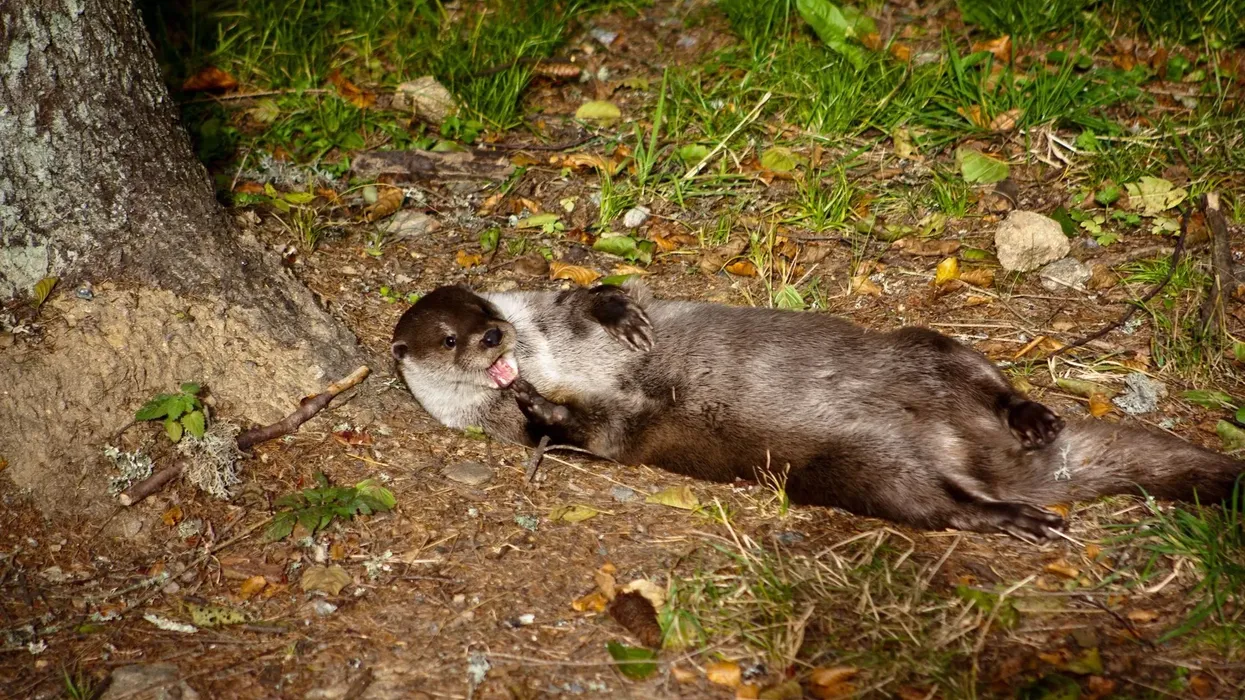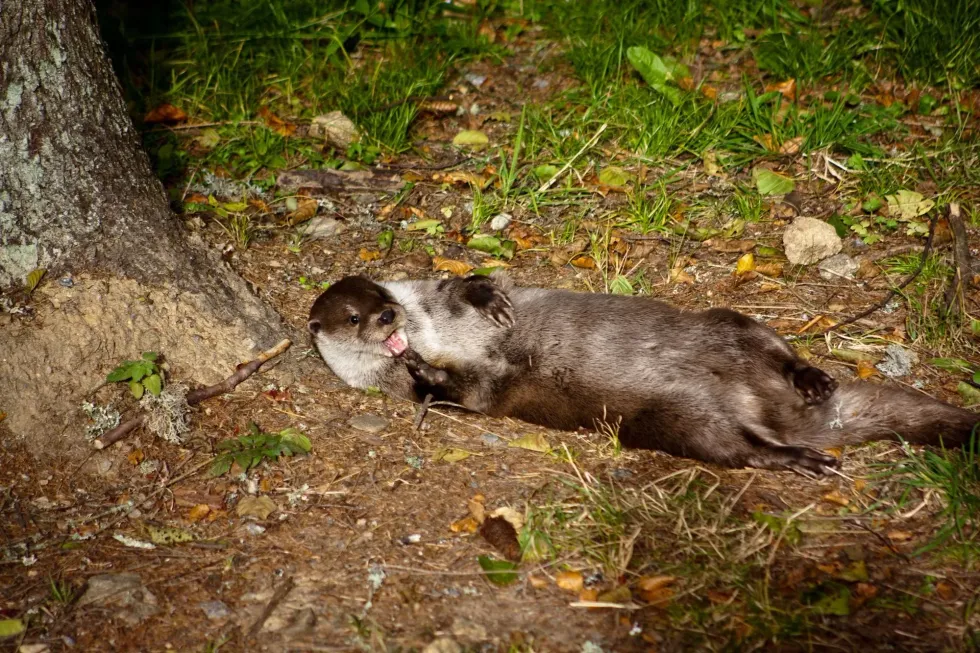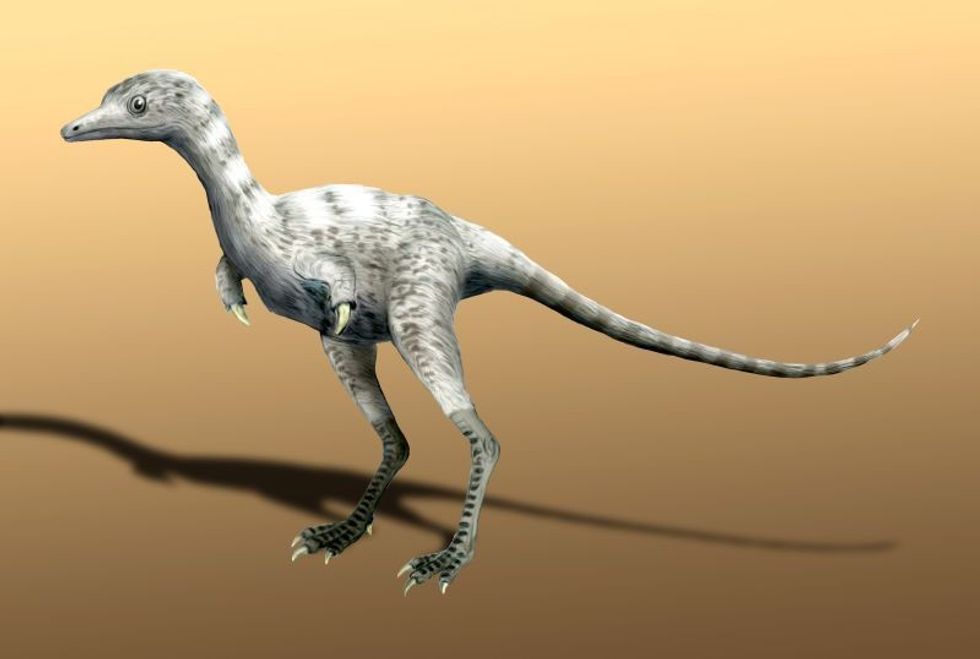Hairy-nosed otter (Lutra sumatrana) is native to Southeast Asia in countries namely Cambodia, Indonesia, Malaysia, Thailand, Sumatra, and Vietnam. It is a semiaquatic mammal and the rarest among the otter species.
This species is highly Endangered due to increased poaching, pollution, and hunting. It is still found in the aforementioned countries but, has become extinct in Brunei, Myanmar, and India.
Hairy-nosed otters of order Carnivora, family Mustelidae, belong to the genus Lutra. They live in swamp forests and wetlands but, can also accommodate themselves in artificial aquatic habitats.
These carnivorous mammals primarily feed on fish and water snakes and occasionally prey on frogs, lizards, crabs, and even insects as supplements. They usually weigh between 11-18 lb (5-8.2 kg) and their body and tail length range between 22.6-32.5 in (57.4-82.6 cm) and 13.8-20 in (35.1-50.8 cm), respectively.
They have short, brown fur all over their body and tail, and hair on their rhinarium. Their breeding season falls between November to March and they reproduce 2-3 pups on average.
Keep reading to know more interesting facts about hairy-nosed otters! For more relatable content, check out river otter and European otter facts.
Hairy-nosed Otter Interesting Facts
What type of animal is a hairy-nosed otter?
A hairy-nosed otter (Lutra sumatrana) is an otter species. Although it is the rarest among this species, it might be difficult to distinguish and identify it among the other types of Asian otters.
What class of animal does a hairy-nosed otter belong to?
Hairy-nosed otters belong to the class Mammalia. Although they are semiaquatic creatures, that is, they live both on land and in water, they are not amphibians as they do not have gills for breathing.
How many hairy-nosed otters are there in the world?
The exact number of hairy-nosed otters that are living today is unknown. This otter species is an Endangered one and was thought to have become extinct in 1998 but, new offspring were found in 2020. However, they are rare and vulnerable with a decreasing population trend.
Where does a hairy-nosed otter live?
A hairy-nosed otter lives in countries namely Cambodia, Indonesia, Sumatra, and Vietnam in Southeast Asia. These otters are also found in Malaysia and Thailand.
What is a hairy-nosed otter's habitat?
Wetlands are the usual habitat of a hairy-nosed otter. It prefers swamps and marshes. The peat swamp forests of Thailand and Vietnam, the flooded forests, mangroves, and estuaries found in Cambodia are inhabited by it. It also inhabits the coastal areas and freshwater found in Malaysia. It can also accommodate itself in an artificial aquatic habitat.
Who do hairy-nosed otters live with?
Hairy-nosed otters have been found to live in small communities or family groups comprising a maximum of four members. These groups or communities consist of the parents and their babies.
How long does a hairy-nosed otter live?
Hairy-nosed otter lifespan range between 10 - 15 years. However, some have been recorded to live over 20 years in wildlife sanctuaries or in captivity.
How do they reproduce?
Although very little is known about the breeding behavior of hairy-nosed otters, certain information has been recorded by scientists with the help of cameras placed in their habitat. The breeding season falls between the months of November to March.
As they live in small family groups, the members of these groups are found copulating with each other in the water. The male otter engages with a receptive female otter in a playful or aggressive manner before mating.
The copulation takes place for about 10 - 15 minutes. Two to three baby otters are born after being carried by their mother for two months.
What is their conservation status?
The International Union For Conservation Of Nature or IUCN has marked the conservation status of hairy-nosed otters as Endangered. This is due to the increased human activities such as poaching, pollution, and hunting that will one day erase the existence of the cute little Asian otters if they are not conserved.
Hairy-Nosed Otter Fun Facts
What do hairy-nosed otters look like?
A hairy-nosed otter (Lutra sumatrana) has brown-colored fur covering its entire body and tail. The brown color fades on the belly. They are also found to be reddish-chestnut in color.
The rhinarium of this otter is covered with whiskers, and the chin and upper lip are white. This helps to distinguish them from the other types of otters. It has a long, slender tail with a long body.
As it is a semiaquatic mammal, its paws are entirely webbed with elongated claws. Its teeth are smaller and the skull is more leveled than that of other types of otters. A hairy-nosed otter somewhat resembles a European otter.
 We've been unable to source an image of a hairy-nosed otter and have used an image of a European otter instead. If you are able to provide us with a royalty-free image of a hairy-nosed otter, we would be happy to credit you. Please contact us at hello@kidadl.com.
We've been unable to source an image of a hairy-nosed otter and have used an image of a European otter instead. If you are able to provide us with a royalty-free image of a hairy-nosed otter, we would be happy to credit you. Please contact us at hello@kidadl.com.
How cute are they?
Hairy-nosed otters are indeed extremely cute with a small, little snout, round buttoned-eyes, and a grumpy look. The fur covering their body gives them a nice fluff!
How do they communicate?
Hairy-nosed otters communicate among themselves through a chirp. Mother otters use staccato chatter to call their babies. They also hiss and growl when faced with threats.
How big is a hairy-nosed otter?
The body length of a hairy-nosed otter range between 22.6-32.5 in (57.4-82.6 cm). The length of the slender tail lies between 13.8-20 in (35.1-50.8 cm). Basically, they are almost the same size as a European otter.
How fast can a hairy-nosed otter run?
A hairy-nosed otter species can run on land. They can also slide and swim very well. Webbed feet help them to swim quite fast. However, their exact speed is not known.
How much does a hairy-nosed otter weigh?
An adult hairy-nosed otter species (Lutra sumatrana) weighs between 11-18 lb (5-8.2 kg).
What are the male and female names of the species?
The male and female names of this species are referred to as boar and sow, respectively.
What would you call a baby hairy-nosed otter?
A baby hairy-nosed otter is known as a pup or whelp.
What do they eat?
This species is carnivorous in nature. Their primary diet includes fish and water snakes. They also prey on lizards, frogs, crabs, mollusks, turtles, and insects as supplements. At times, they prey upon climbing perch, snakeheads, and crustaceans.
Are they dangerous?
Usually, otters found in Southeast Asia, that is, the hairy-nosed otters are playful and not dangerous but, they might become destructive and start making loud whistling noises out of aggression. They may also bite which feels like a sewing machine piercing the fabric, that is, it is sharp and pierces through the skin.
Would they make a good pet?
A hairy-nosed otter is traded mainly for its cuteness and can make a good pet until it turns destructive out of aggression for not getting what they want. Apart from this, petting this species is not healthy for the animal itself since they require a specialized diet for survival.
Did you know...
There is only one hairy-nosed otter in captivity, Pursat, living in the Phnom Tamao Wildlife Rescue Center at Phnom Penh in Cambodia. This otter was brought in as a baby and grew up there in captivity. It is kept there for the conservation of the species and to gain valuable information about it.
Being a native of the country Sumatra, the hairy-nosed otter (Lutra sumatrana) derived a portion of its scientific name 'sumatrana' from there.
This species is known to hold its breath for eight minutes underwater.
Why is it called a hairy-nosed otter?
This species of otters is called hairy-nosed since its rhinarium is extremely hairy, unlike the other types of otters.
Why is the hairy-nosed otter endangered?
The hairy-nosed otter (Lutra sumatrana) is Endangered due to various human activities such as poaching, pollution, and hunting, posing a huge threat to their habitat as well. Unless this species is conserved in wildlife sanctuaries or parks, it will become extinct.
Here at Kidadl, we have carefully created lots of interesting family-friendly animal facts for everyone to discover! For more relatable content, check out these Indian elephant facts and African bush elephant facts pages.
You can even occupy yourself at home by coloring in one of our free printable smooth coated otter coloring pages.




 We've been unable to source an image of a hairy-nosed otter and have used an image of a European otter instead. If you are able to provide us with a royalty-free image of a hairy-nosed otter, we would be happy to credit you. Please contact us at hello@kidadl.com.
We've been unable to source an image of a hairy-nosed otter and have used an image of a European otter instead. If you are able to provide us with a royalty-free image of a hairy-nosed otter, we would be happy to credit you. Please contact us at hello@kidadl.com.



